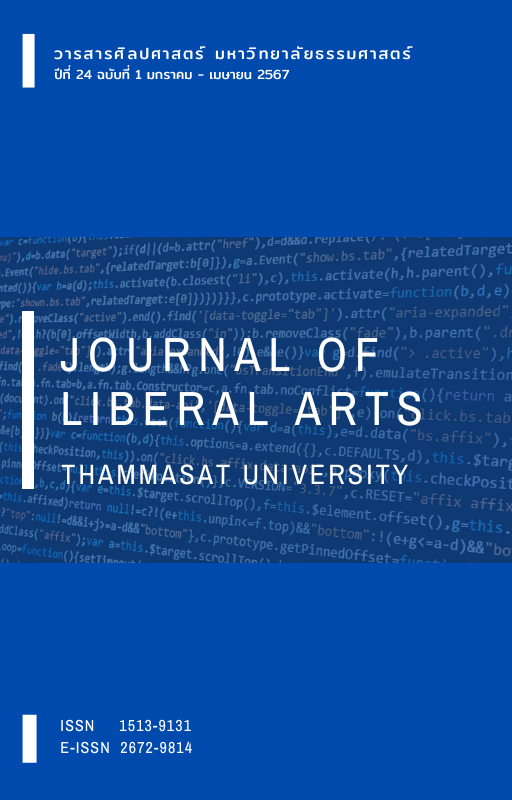Japanese Food (Washoku) as World Heritage and the Government’s Support to be a Sustainable World Heritage
Main Article Content
Abstract
Nowadays, Washoku, or Japanese food, is an important symbol of Japan because it has been registered as a World Heritage exhibiting the following elements: 1) respecting nature, 2) being nutritious, 3) being visually attractive, 4) being linked to culture, tradition and festivals. This academic paper collects and analyzes information on the definition, components, and uniqueness of Washoku as considered and defined by UNESCO. It recognizes in Washoku a unique tradition rich in nature, nutrition, beauty, and connected to a good culture. When these elements are combined, they further emphasize the uniqueness that UNESCO has designated Washoku a World Heritage. From the data collection, it was discovered that Washoku has a distinctive point that links to the management of many agencies who support Washoku as a world-class cuisine. This paper will allow those people who are interested in Washoku to know about it more deeply.
Downloads
Article Details

This work is licensed under a Creative Commons Attribution-NonCommercial-NoDerivatives 4.0 International License.
References
กรมวิทยาศาสตร์บริการ. (2530). มิโซะ (Miso) อาหารราคาถูกแต่ทรงคุณค่าของญี่ปุ่น. วารสารกรมวิทยาศาสตร์บริการ, (113), 29-32.
ณัฐหทัย คงพิทยาพันธุ์. (2560). พิซซ่าญี่ปุ่น กับ โอะโคะโนะมิยากิ : มุมมองอาหารญี่ปุ่นจากทัศนะของชาวญี่ปุ่นกลุ่มหนึ่งในสังคมไทย [รายงานการศึกษาเฉพาะบุคคลปริญญาบัณฑิต, มหาวิทยาลัยศิลปากร]. Silpakorn University Repository: SURE.
โนะบุโอะ ฮาราดะ. (2563). วาโชะคุคืออะไร เจาะลึกวัฒนธรรม ความอร่อยอุมามิ (สรัญญา คงจิตต์, ผู้แปล). วนิดาการพิมพ์. (ต้นฉบับพิมพ์ปี 2557).
พัชรา สายวิเชียร. (2550). วัฒนธรรมอาหารของครอบครัวญี่ปุ่น [วิทยานิพนธ์ปริญญามหาบัณฑิต, มหาวิทยาลัยเชียงใหม่]. CMU Intellectual Repository.
สุดสวาท จันทร์คำ. (2554). ความเชื่อและพิธีกรรมเกี่ยวกับข้าวและการเพาะปลูกข้าว. วารสารญี่ปุ่นศึกษา, 17(2), 39-62.
สิรินารถ สุวรรณโภคิน. (2562). แผนธุรกิจร้านอาหารญี่ปุ่น “คุจิคัตสึ” [วิทยานิพนธ์ปริญญา มหาบัณฑิต, มหาวิทยาลัยกรุงเทพ]. DSpace BU Research.
Ehara, A. (2015). Washoku culture inscribed on the UNESCO’s intangible cultural heritage list, and the way of the protection and promotion. Journal of Cookery Science of Japan, 48(4), 320-324. (in Japanese)
Farina, F. (2018). Japan’s gastrodiplomacy as soft power: Global washoku and national food security. Journal of Contemporary Eastern Asia, 17(1), 131-146.
Kakiuchi, E. (2016). Cultural heritage protection system in Japan: Current issue and prospects for the future. Gdansk East Asian Studies, 10, 7-27. https://doi.org/10.4467/23538724GS.16.013.6170
Kumakura, I. (2014a). Washoku: Balanced and healthy. Food Forum, 28(2), 1-8. https://www.kikkoman.com/en/foodforum/the-japanese-table/28-2.html
Kumakura, I. (2014b). Washoku: Respect for nature. Food Forum, 28(1), 1-8. https://www.kikkoman.com/en/culture/foodforum/the-japanese-table/28-1.html
Kumakura, I. (2015). Washoku: Social customs and observances. Food Forum, 28(4), 1-8. https://www.kikkoman.com/en/foodforum/the-japanese-table/28-4.html
Kordzinska-Nawrocka, I. (2019). Japanese culinary culture and identity. Analecta Nipponica Journal of Polish Association for Japanese Studies, 9, 61-73.
Ministry of Agriculture, Forestry and Fisheries. (2007). Selection of 100 regional dishes. https://www.maff.go.jp/j/nousin/kouryu/kyodo_ryouri/panf.html (in Japanese)
Minister of Agriculture Forestry and Fisheries. (2016). Further spreading the appeal of Japanese food to the world. https://www.maff.go.jp/result.html
Ministry of Agriculture, Forestry and Fisheries. (2022). Japanese food is registered as a Unesco Intangible Cultural Heritage. https://www.maff.go.jp/j/keikaku/syokubunka/ich/ (in Japanese)
Morisaki M., & Suda, F. (2017). Market agencements of Japanese food cultures. In Societe Francaise d’economie rurale, 11es Journées de Recherches en Sciences Sociales (pp. 1-15). Lyon.
Sato, Y., & Al-alsheikh, A. (2014). Comparative analysis of the Western hospitality and the Japanese omotenashi. Kwansai Gakuin University Graduate School of Business Strategy, Business & Accounting Review, (14), 1-15. (in Japanese)
Sato, Y., Hiraiwa, H., & Al-alsheikh, A. (2014). Characteristic of Japanese omotenashi: in relation with development of Japanese kaiseki cuisine based on tea ceremony. Kwansai Gakuin University Graduate School of Business Strategy, Business & Accounting Review, (14), 17-37. (in Japanese)
Ueda, H., & Niiyama, Y. (2019). Articulating challenges in defining Japanese washoku and French gastronomy: Comparative analysis of inscribed definitions and their safeguarding measures. Journal of food system research, 26(3), 144-164.
United Nations Educational, Scientific and Cultural Organization. (2013). Washoku, traditional dietary cultures of the Japanese, notably for the celebration of New Year. https://ich.unesco.org/en/RL/washoku-traditional-dietary-cultures-of-the-japanese-notably-for-the-celebration-of-new-year-00869


